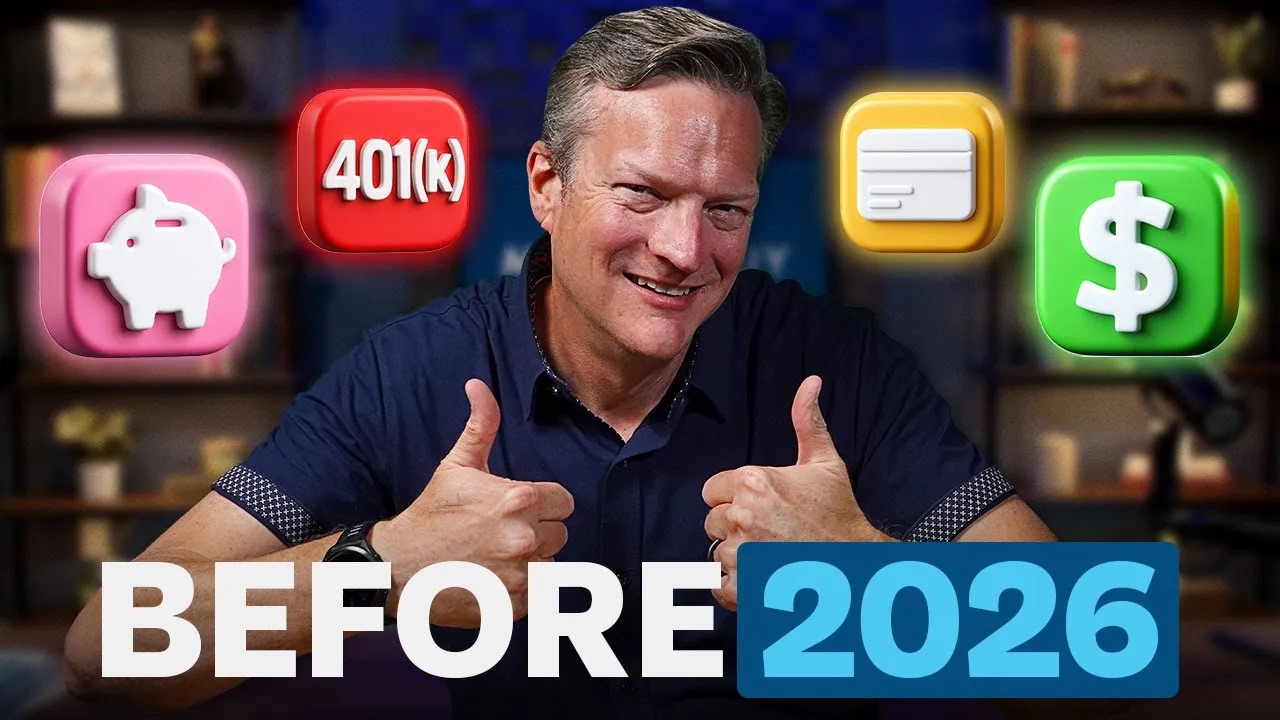So, Brian, let’s talk. Let’s start at the beginning; let’s talk about the 20s. Because at this stage, it’s likely that you are not wealthy yet, but you probably have a desire to be wealthy. So, in this stage, it’s very important to begin focusing on what are the things that I should be thinking about and what are the things that I should be avoiding. This one should be the easiest stage. I always say 20-year-olds have the biggest opportunity, and we’ll talk about why in a second.
But the thing that I think gets 20-year-olds is procrastination. They think they know that they’re young, so they’re like, “Hey, I’ll just push this off.” Plus, it’s consumption because you get your first job in your 20s and you realize, “Hey, you know what? I can use some of this newfound money that’s coming in, and let’s start boosting our lifestyle by monthly payments.” It’s so easy to think, “Okay, in my 20s, whether I’m racking up debt—oh, I’ve got plenty of time to pay that off—or whether I’m not saving—oh, you know what? Retirement is so far away; I have plenty of time.” And while that is true when it comes to being wasteful, it is exponentially more expensive to waste time than to waste money. So, I think in your 20s, you have to really focus on that so that you don’t flip your financial life upside down.
I think that there’s a true present bias; we love instant gratification. When you think about deferred gratification, which we all know is the building blocks discipline to the first ingredient of wealth-building, it’s just so easy just to say, “You know what? I have plenty of time; I’m going to focus on today.” But that is not healthy. Bo, you actually have some stats to give a little color to this.
Yeah, if you look at those in their 20s right now, those in the Generation Z, they have an average credit card debt balance of $2,800. So, on average, $2,800 in credit card debt. Well, when you flip that and look at Americans in their 20s, they have a median retirement savings of about $6,700. So, one thing here is encouraging; it looks like Gen Zers are saving. They have something built up in retirement savings, and if they understand how money works, that’s incredibly valuable. But seeing that there’s an average debt balance makes me sad because there is no way to get ahead if you’re racking up credit card debt, especially if you take into account Gen Z is 18 to 26 years of age. So, already having $3,000 worth of consumer debt is a lot if you think about it.
Coming out of the gates because we all know those rates right now. We recently saw, I thought I was just assuming credit card rates were around 20% or a little over 20%, which is already just—I don’t see how in the world you get out from underneath that. But then I have recently seen actual credit card statements for people that it’s over 30%, right? So, if this is you, be careful because debt is a bridge to nowhere. It’s a trap; it’s a false start. Don’t use debt as your gateway into consumption. Yeah, we tell you all the time that compounding interest can be your most fantastic ally; it can be your fiercest adversary. And it’s because we understand how our wealth multiplies through time.
If you’ve not checked this out, you can go check out this resource at moneyguv.vn to work on how it can be for you in your 20s. Well, if you think about that the other way, every dollar you consume in your 20s can be very expensive. That’s why we have these koozies that say, “This $1 beer cost me $88.” So, if you can flip your mindset into thinking about how valuable even small sums can be right now, you’re going to give yourself a huge leg up when it comes to your 30s, 40s, and 50s.
I think the wealth multiplier is a perfect segue into how do you actually get ahead? Because you have, in just droves, the quantity that we are—anybody who’s older, we’re jealous of you. Why do you think so many explorers are looking for the Fountain of Youth and other things? It’s because we’re always looking to capture as much time as possible. For all of you watching this in your 20s, you have it. So, there is great responsibility with this very valuable resource of time because, as I’ve shared with you, discipline leads to—if you can be disciplined and have deferred gratification, it allows you to build margin or create money.
But the most valuable ingredient to wealth creation is actually the third component, which is time. So, don’t waste the most valuable thing that you have because it’s almost impossible or hard to screw it up if you just understand what you have and actually maximize it. And that leads perfectly into if we’re thinking about not wasting time or making the most of our time, we also ought to think about how are we acting and behaving as consumers? What are the things that we’re doing, and are we recognizing that the things we spend our money on, the things we spend our time on, are actually worthwhile endeavors?
I think one of the things that I see happen all the time for young folks is they begin to recognize, “You know what? I can afford anything in the world in just four easy payments. Why, in just $9 a month, if I just stretch it over 60 months?” And you don’t recognize that that small, easy monthly payment actually turns into a fairly sizable annual payment. That annual payment could actually turn into a sizable retirement savings. But we don’t focus on that; we only focus on that short term, that monthly thing, and it causes us to overconsume and undersave in our 20s.
Well, it’s all the rage right now with all the essentially expanded out or buy now, pay later. So, instead of thinking, “Hey, you can do it for everything now,” if you think about the fact that a $9 a month purchase, if you think about the point of sale transaction, like $9, that’s just not much money. But I need you to open your mind and think about that; that $9 is actually $100 a year. That $100 a year potentially is $10,000 from your future retirement. That is the way you need to be thinking about this. I love, but I hate being negative, and this is the part that I hate that everybody is focused. You know, you think about it as what can I buy with that $9? We’re thinking about what you can build with that $9 that turns into $10,000. That’s why when we bring up like wealth multipliers and other things, get on fire with that concept because if you can get addicted to saving and building for the future, there is no limit to what you can create for yourself.
And learn how to actually differentiate between the things that you truly need and the things that you want. I mean, you need a reliable, dependable automobile to get you from your house to your work in a lot of circumstances. You might want a nice car, a luxury car, a car with all the bells and whistles. Well, is buying that in your 20s the most prudent decision you can make, or should you focus on reliable transportation? So, you ought to figure out how to use tools and tricks to impact how you consume so that you make sure you’re making wise consumption habits.
Well, we talk about this; you’ve got to make the good habits easy and the bad habits hard. So, a big part of that is obviously gamifying the situation. You know, why don’t I pay myself first? Why don’t I make sure that I have allocated enough of my resources so that there’s not all this wants versus the needs and separation? This is the type of stuff that’s actually going to help you do so. Let’s actually talk about what are the guardrails to protect people.
Yeah, I think in your 20s, if you can recognize the guardrails, the big things that will keep you out of the ditch, you’re likely to set yourself up for success. And the guardrails are not incredibly complicated. Number one, are you following the Financial Order of Operations? You can go to moneyguy.com/resources. Do you know the best use of your next dollar? Should it be going to get that employer match? Should it be paying off high-interest debt? Should it be building up your emergency fund? Well, if you know the best use of your next dollar, it will naturally keep you on the right path towards wealth-building.
You know, I held up, if you go to moneyguy.com/resources, we obviously have the Financial Order of Operations there. We’ve already talked about the wealth multiplier. But, guys, here’s what I want to tell you: it’s also a matter of saving and investing. Twenty-five percent is both covered, but it’s 25 put guardrails up on what you’re owning. We have an entire resource there on housing; check that out. And then, of course, two-thirds. I’ve seen so many of my friends, when I was younger, that had paid-for cars that were reliable, got them through college. But then, as soon as they graduated, they’re like, “You know what? I deserve, or I have earned, something nicer.” And then they go load up the auto debt because there’s an entire industry that’s giving you graduation discounts, $1,000 toward purchases. They have created an entire sector just for graduates, and they’re trying to encourage you to get on the debt train. And, guys, I’m telling you, do not try to impress neighbors or friends; they do not care. What does care is your 50-year-old version of yourself that’s sitting out there crying and waiting, saying, “Please make the right decision so that we can have the best version of ourselves.” Because if you can sacrifice, if you can do deferred gratification in that decade of your 20s, you give us 10 years, you get 50, 60, 70 years to reap the benefits from this. You have to understand that small deferred taking a little bit today for that great, more beautiful tomorrow is what you’ve got to focus on.
I love it, Brian. This goes without saying; credit card debt is no way—like, you should not be carrying your credit card balance. If you find yourself racking up credit card debt, not paying it off monthly, you may just not be a credit card person. So perhaps you need to do away with them, leave them at home, cut them up, don’t use them. Now, you just said something so beautiful, Brian; you said that if I can just defer a little bit of today for that great, big, beautiful tomorrow, it becomes really, really exciting. We wanted to put together an illustration to show you just how powerful that can be in your 20s. So we had the team put this together, and this goes from age 20 to 29. And this is basically what we said: if you can save an additional 1% of your income today, how much of your future retirement income or pre-retirement income would you be able to replace?
So, I’ll use a 25-year-old for example. Every 1% that you can save at 25 has the propensity to replace 6.6% of your needed retirement income in retirement. So those small incremental changes that you’re talking about, Brian, can have a huge impact if you start today. But you notice, as you age, as you move through time, the numbers drop a little bit lower, a little bit lower, a little bit lower. So the sooner you figure this act, the more impactful those incremental decisions can be.
Yeah, I mean, I want you to think about that ’cause I’m going to go even bigger with like, think about most people graduate college when they’re 22. If I can just convince everyone when they get out there in the workforce—it doesn’t even have to be college, maybe you finish trade school and you’re just getting out there—all those people in their early 20s, every 1% you can give us right now is going to be essentially close to a tenth of your retirement income. That’s not—that’s not—it’s just going up a little bit; we’re talking about this is hundreds of thousands of dollars by making one small little decision today to have that better tomorrow. Guys, this is what builds financial empires. Take it serious; don’t wait another day because this is your moment to conquer the future and have the best version of yourself. And the other last little thing I’ll throw out that is in your 20s, maybe you’re not able to save 5%. Maybe you’re just getting your employer match, and you’re saving 5%. Let this illustration be fuel for the five. Okay, you know what? Next year, I can do 6%. Okay, I can go from 6% to 8%. Just saving a little bit more can have a huge impact. So don’t miss that opportunity.













